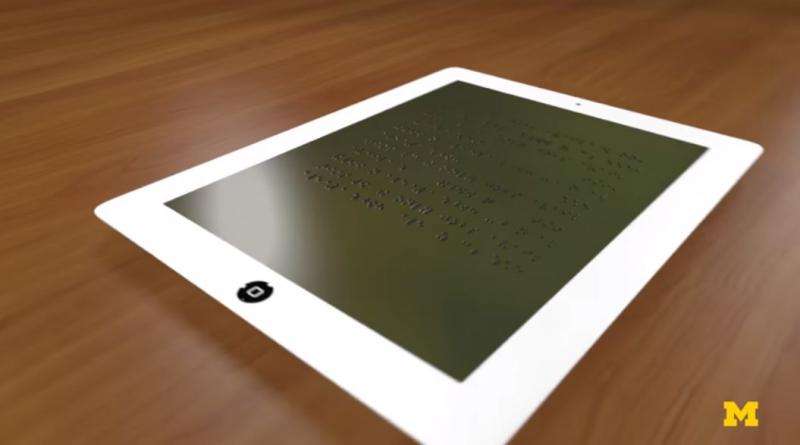January 17, 2016 weblog
Michigan team work on Braille tablet display to widen access

Braille displays for the blind are one way for the blind to access information. The National Braille Press said technology for Braille displays has been around for several decades, but since blindness is a low incidence disability in the United States, "the size of this market does not encourage the same innovation as found in mainstream technology."
Some refreshable Braille displays can be expensive, in the $3,500 to $10,000 range. What is more, they may lack the same features as sighted people have come to expect.
In Michigan, a research team is well aware of the shortcomings and is doing something about it. They know how cumbersome reading a computer screen in Braille may be; visually impaired people who rely on the system of raised dots only have access to one line at a time—think about trying to read a book that way on a Kindle.
Members of the research team include Sile O'Modhrain, who holds a Ph.D. in computer-based music theory from Stanford. O'Modhrain's research focus is on haptics–touch and gesture. Brent Gillespie is an associate professor of mechanical engineering with research interests in haptic interfaces and robotics. Alexander Russomanno is a Ph.D. candidate in the Department of Mechanical Engineering at the University of Michigan, Ann Arbor.
MIT Technology Review commented that existing refreshable Braille displays tend to max out at one line of text and cost several thousand dollars. They use plastic pins pushed up and down by a motor.
Also, the team would like to provide better access to charts and graphs to ease the limitations on lack of access to spatially distributed information.
The device to pave the way to easier Braille tablet access for blind users is under development at the University of Michigan.
Signe Brewster in MIT Technology Review said the results of their efforts may be that "An inexpensive, full-page Braille tablet could make topics like science and math more easily accessible to the blind."
Text-to-speech software is one way to access information for the blind, but, quoted in MIT Technology Review, "Anything where you want to be able to see stuff written down, like coding or music or even just mathematics, you really have to work in Braille," said O'Modhrain.
Their goal is a full-page Braille display, and the difficulty of their undertaking was control, said Russomanno. How do you control all the features, that could be anywhere from five to ten thousand dots, he asked, "How do you control that many physical features without it becoming so large that you cannot carry it around?
He said that they have a potential solution to that problem. That solution will allow them to control all those features in a very small space, to be packed in and portable.
"The method relies on the pneumatic use of liquid or air to shrink the mechanism and expand it so it can display more at once," said the video notes. Their goal is for it to display the equivalent of a page at once.
MIT Technology Review explained how tiny bubbles in popping up create the blocks of raised dots for Braille. "Each bubble has what is essentially a logic gate that opens or remains closed to control the flow of liquid after each command," wrote Brewster.
O'Modhrain said that their display is entirely pneumatic, which means that they can drive it with air or fluid. "In practice what that means is that we have a series of bubbles which are either inflated or not inflated. These bubbles in turn push dots up and down."
She said that also means they can produce a display a lot cheaper than existing displays which depend on electronics so that they do not worry about wiring; they never have to worry about assembling individual mechanical objects. "We just build up layers of bubbles."
Using the microfluidic option, said Brewster, could help make the final product tablet-sized instead of laptop-sized.
Lory Gil in Liliputing said the technology also makes it possible to fit as much as 10,000 dots on the screen, "which would allow for interpretation of complex data, so visually impaired persons could read scientific and mathematical information from a tablet more easily."
As for costs, the approach could help bring costs down. "The tablet borrows manufacturing techniques from the silicon industry," wrote Brewster, "where chips are laid down in layers instead of having many small parts to assemble. As a result, the Michigan team is aiming to offer a Braille tablet for less than $1,000."
© 2016 Tech Xplore



















